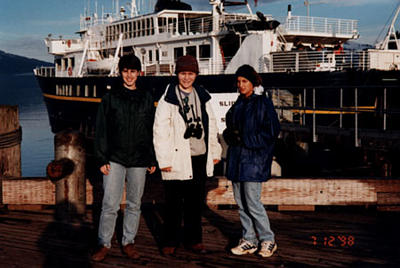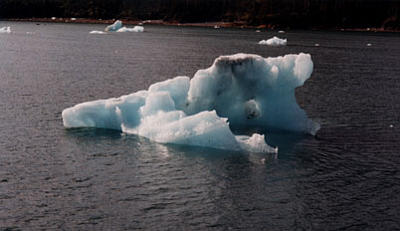
|
|
12 July, 1998
Myrtle Brijbasi
TEA/Alaska - 98
Journal Entry 3 - July 12, 1998
Travel to Seward, Ak
I'm awakened about 5.am to the sound of chirping birds and the
sunshine streaming through my window. My window overlooked the Valdez
marina, the backdrop of which were snow-capped mountains. I was
captivated by this scene and sounds. I slowly got ready for the day's
activities. We were leaving for Seward, via Whittier and Portage -
an 8 hour trip, lots of time to enjoy the panoramic view of the Valdez
Arm, Prince William Sound, the famous glaciers of that region, and all
the wildlife we can possibly see. It was a pleasant morning, a cool 47
degrees with a projected high of 67 degrees. As we walked along the
docks waiting to board the State Ferry - the E.L. Bartlett, we saw sea
otters feasting on their catch, and a variety of birds. Passengers
were confined to the two upper decks , both partially enclosed, with a
solarium on the uppermost deck. All vehicles and heavy luggage were
stored on the lower deck (1st level). The view from the ferry was
great from all angles. One of the features of the daily ferry service
is having a naturalist on board who is an informant on all of the
features of the ferry route - history, geology, forestry, and pointing
out specific locations for the perfect photo opportunities. Of course,
we heard all about the Exxon Valdez oil spill as we passed by the
Alyeska Pipeline terminal. Again, details were given about the many
precautionary measures that have been installed to prevent any such
disaster from reoccurring.
As we traveled thorough the Valdez Narrows, the Shoup and
Anderson glaciers and Mount Shasta were identified. The receeding
features of these glaciers were also explained. As we left the Valdez
Arm and entered the widening Prince William Sound, Bligh Reef was
pointed out to us - the ill fated location of the grounding of the Exxon
Valdez in 1989. We then traveled westward to glacier island through
Columbia Bay (commercial route), about six miles from the calving area
of the glacier. Mysterious blue, blue and white, and blue white and
black icebergs of all shapes and sizes, drifted away from the glacier
into the sound. Each iceberg had a unique shape, and drifted at
phenomenal velocities hitting the sides of the ferry. This was awesome.
I was spellbound and in total in amazement to witness such an act of
nature. It was also very windy at that time and some icebergs came
crashing into the sides of the ferry. Certainly, the thoughts of
Titanic entered many people's minds ... including mine. Even though
many of the closer icebergs appeared small, we had to remember that we
were only seeing one-tenth of their size. The calving area of the
Columbia glacier was massive. The wide vertical drop stood majestically
like a retaining wall in the distance, beautifully reflecting the blue
light.
Being very excited about seeing real icebergs, I was trying to
capture as much as I could on film. And then the most spectacular
event of nature occurred. You would not believe what I witnessed. I
saw a huge iceberg take a nose dive, and reemerge as a totally
different shape and form. How amazing.!!! I kept saying to the
people around me - "did you see that ?" over and over again, not
realizing until afterwards that they too were asking the same question.
It is one thing to read about natural events occurring in extreme
environments, but it is another thing to experience it. The ferry
continued its route around glacier island and on to Whittier. Along
the way we saw large cruise ships, fishing boats, more wildlife - sea
gulls, acrobatic sea otters and purposes. I was hoping to see whales,
but was not that lucky.
For the benefit of everyone on board, the naturalist gave an
excellent demonstration of how glaciers are formed, and explained the
calving mechanism. She also explained why the icebergs appeared blue,
why there were the blackened areas of some of the icebergs, and why the
surrounding water appeared turquoise,
Blue - reflection of light through the compact ice crystals.
Black - sections of rock that break off with the glacier during the
advancement and calving of the glacier.
Turquoise water - the mixing of the glacial silt in the surrounding
water.
Just before the ferry docked in Whittier, it passed a nearby
cliff on which were a flock of kittiwakes. It was one of the many
rookeries of the sound. The unique behaviors of the birds were also
explained. We also saw several waterfalls, all very beautiful in
their own way.
What a trip!! ..... long, but never a dull moment.
Whittier is an interesting place. A town that exist in one
highrise building sitting at the foot of the mountains, with several
abandoned buildings around it that once housed army personnel. The
marina was very small but very picturesque. Across from the marina was
the mighty Alaska Railroad cars. We boarded the rail car and sat on
the upper deck from where we could have a good view of our scenic
route- vast, pristine, arctic wilderness and a tunnel. Shortly after
emerging from the tunnel, we were in Portage. There we were met by Dr.
Merav Ben-David (My Principal Investigator for the River Otter Project)
who was driving us to Seward. It was a very pleasant meeting and warm
reception.
On our way to Seward, Dr. Ben-David gave us a crash course on
the Kenai Peninsula - its geologic history and the formation of the
fjords, its geography, and its unique arctic ecology. This was very
informative and interesting. This was a drive-by field trip. The
Alaskan highway is an endless stretch of two-lane roads - one lane in
each direction, except at a major intersection. It is not uncommon to
see people pull off on the shoulders of the road just to enjoy the
scenery, or to look more closely at the wildlife. We were no different.
Having sighted a large moose in one of the bog areas along the forest
edge, we pulled off the road, parked on the shoulder, took out our
binoculars and spent a few minutes observing the moose. Dr. Ben-David
also pointed out to us places of interest - for example the salmon
hatchery and the nearby lake where there is an extensive salmon
aquaculture program in operation. She also shared with us the fact that
based on artificial spawning, there is some degree of genetic drift,
and the selection of the good genes in salmon population is affected .
However the fish biologists are doing their very best to maintain
genetic equilibrium of salmon species. We stopped at the grocery
store to stock up on supplies for a few days, and headed to the
university apartments where we will be staying for the duration of our
assignment in Seward.
After unloading our stuff - lots of it, we rested for a while,
then joined Dr. Ben-David and Susanne Trillhose for dinner . Susanne
is one of her students who is working on the River Otter Project. We
returned to the apartments after dinner, and went for a walk along the
road behind the Sea Life Center which leads to a park, private property,
and camping ground. A very forceful waterfall came tumbling down the
rocks near to the road, emptying into a stream that connected with the
bay - Resurrection Bay. Both people and a flock of gulls were competing
for fish in this stream, with both sides experiencing success. On our
way back to the apartments, Elisa and I collected some wild flowers
which we pressed later. While we were picking the flowers, we saw a
porcupine trying to make its way under a fence. After a few
unsuccessful attempts, it moved towards the open area. By that time we
were flashing cameras at it and I think that disoriented it a little.
Well, Well, Well, wasn't that a full day? and guess what? I am
not tired. It is about 11.30 pm, and it still light out. Anyway, I
have to rest in order to be fresh and ready for the first day of our
project. Tomorrow we get to meet the river otters, all fifteen of
them. Yeah!!
Before I sign off, here is Noa, who wants to express some of her
inner feelings of Alaska with you -
Today epitomized the scenic spirit of Alaska. The ferry floated
on the unique steel-blue waters filled with the regional glacial silt.
Mountains rose up on either side of the waterway, flaunting a diverse
collection of flora and fauna. They start at the bottom with a lush
boreal forest with stately evergreens covering every visible spot. It
slowly fades into an alpine tundra that covers the middle third of the
mountain with a green blanket of short shrubbery. It provides a
beautiful contrast to the dark gray of the snow-covered peaks. The
bright blue sky is yet another shade in the panorama of blues, grays,
and greens. Everything is massive and still and breathtakingly
beautiful; the power and majesty of Nature are apparent and you feel
happy just to be alive.
-Noa Levanon

ARCUS Project Coordinator, Renee Crain stands with Elisa Maldonado and Noa Levanon in front of the ferry prior to boarding for the 7 hour trip to Whittier.

Ice berg following a roll-over.
Contact the TEA in the field at
.
If you cannot connect through your browser, copy the
TEA's e-mail address in the "To:" line of
your favorite e-mail package.
|
